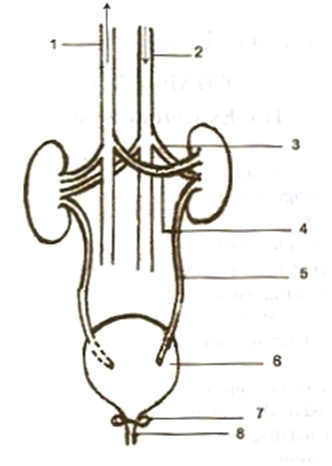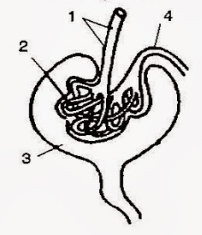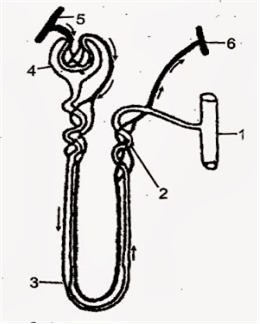For Daily Free Study Material Join wiredfaculty
Home > The Excretory System Elimination Of Body Wastes
The Excretory System Elimination Of Body Wastes
Mention the exact location of the following structures:
v. Loop of Henle
Loop of Henle is present in the inner medulla region of kidney.
Some More Questions From The Excretory System Elimination of Body Wastes Chapter
Mention the exact location of the following structures:
v. Loop of Henle
Draw neat and labelled diagrams of the following:
i. Malpighian Capsule
The diagram given below shows the male urinogenital system of a human being. Study the diagram and answer the questions that follow:
i. Label the parts numbered 1 to 8.
ii. Name the corresponding structure of part (4) in female reproductive system.
iii. What is the role of part 7? [5]
Explain the following terms:
Selective reabsorption.
Name the following :
The structural and functional unit of the kidney.
Study the diagram given below and answer the following questions: 
(i) Name the region in the kidney where this structure is present
(ii) Name the parts labelled 1, 2, 3 and 4.
(iii) Name the stages involved in the formation of urine.
(iv)What is the technical term given to the process occurring in 2 and 3? Briefly describe the process.
Give reasons for the following:
(ii) Urine is slightly thicker in summer than in winter.
Given below are six sets with four terms each. In each set one term is odd and cannot be grouped in the same category to which the other three belong. Identify the odd one in each set and name the category to which the remaining three belong. The first one has been done as an example.
Example: Calyx, Corolla, Stamens, Midrib
Odd term: midrib
Category: Parts of a flower
(ii) Urethra, Uterus, Urinary bladder, Ureter
The given diagram represents a nephron and its blood supply. Study the diagram and answer the following questions:

i. Label parts 1, 2, 3 and 4.
ii. State the reason for the high hydrostatic pressure in the glomerulus.
iii Name the blood vessel which contains the least amount of urea in this diagram.
iv. Name the two main stages of urine formation.
v. Name the part of the nephron which lies in the renal medulla.
Sponsor Area
Mock Test Series
Mock Test Series